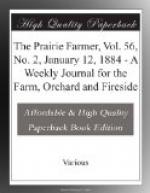APIARY APPLIANCES.
In the last issue of THE PRAIRIE FARMER the “Italian and German Bees” were described true as life, by that prince of writers, L.L. Langstroth. After a careful perusal of the article named, in which the good and bad traits of each race are delineated, any person ought to be able to choose intelligently which bee is best, all things taken into consideration, for him to procure.
In starting an apiary, there is another item of equal importance, and that is what kind of dwellings should be erected for the occupants of this future city. The wants of the future tenants should be considered; provide them with all modern conveniences, as to pantry and larder, and don’t forget, as some architects do, that abodes should be ventilated as well as warm. Some bee-masters prefer houses that are high between ceilings, others low; some prefer large houses, many again those that are smaller. The size has to be made according to the frame chosen. There are five different sizes of movable frames now in use among bee-keepers, and those are equally successful who use either size. The Langstroth is more in common use than any other. Some object to it, claiming that it is too shallow.
[Illustration]
In looking at the plates of the five different sizes of frames, an idea is gained how minds differ. Each one has its advocates, and its votaries claim that the frame they use is the very best for all purposes. We were once looking out of the window of a friend’s house on her neat, well-kept apiary, and remarked what baby hives. And we found no fault with the baby, when this lady showed us her beautiful white sections of comb-honey, and ate her delicious peaches, canned, with extracted honey for sweetening.
It must be fun to handle the little Gallup, but the Langstroth has an advantage over all others; it consists in this: that it is most used, and if a person desires to sell his hives and frames, he can more readily do so. It is also easily obtained, as it is kept in stock by supply dealers, and can be quickly sent forward when ordered, but if it was an off size wanted, a delay would occur; some change might have to be made in the machinery, and it would cost more, as well as the delay occasioned, which, if in the midst of the honey harvest, might cause great loss.
Other appliances of the apiary, to suit this frame, are kept by supply dealers; such as extractors, comb-baskets, uncapping cans, etc. With any of these frames a hive can be made large or small, by regulating the number of frames. If the hives are bottomless, as many make them, a tall hive can be made by tiering up, as is practiced by those who work for extracted honey. The Adair frame was formerly used in a hive called the “New Idea, or Non-swarming Hive.” Its non-swarming qualities consisted in its being a long hive, and if empty frames were always kept in front, so that the bees had to pass through empty space to reach the brood nest, they would not swarm.




